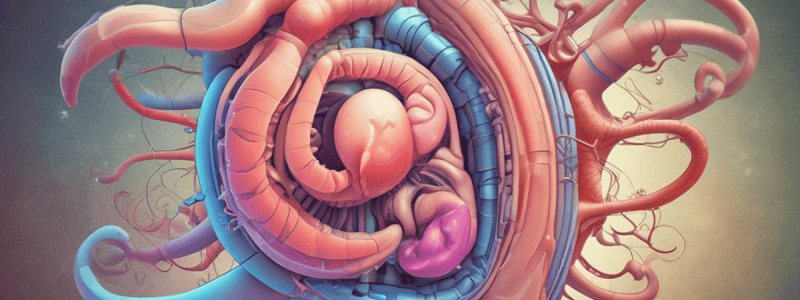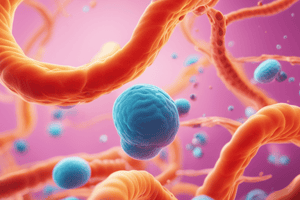Podcast
Questions and Answers
What is the primary mechanism of acid secretion in the gastric mucosa?
What is the primary mechanism of acid secretion in the gastric mucosa?
- Cholinergic stimulation of acid secretion from parietal cells
- Neurotransmitter-mediated increase in histamine release from ECL cells (correct)
- Parasympathetic stimulation of gastrin release from G cells
- Hormonal regulation of pepsinogen secretion from chief cells
Which of the following GI pathologies is characterized by narrowing of the pyloric canal?
Which of the following GI pathologies is characterized by narrowing of the pyloric canal?
- Acute gastritis
- Pyloric stenosis (correct)
- Peptic ulcer
- Gastroesophageal reflux disease
What is the primary cause of parietal pain in the gastrointestinal tract?
What is the primary cause of parietal pain in the gastrointestinal tract?
- Stretching of the peritoneum or underlying muscles
- Mediators of the inflammatory response stimulating afferent nociceptor fibers (correct)
- Inflammation
- Ischemia of the peritoneum or underlying muscles
What is the primary function of the liver in the GI tract?
What is the primary function of the liver in the GI tract?
Which of the following is NOT a pathology related to gastric mucosal function?
Which of the following is NOT a pathology related to gastric mucosal function?
Which of the following is a common symptom of nausea?
Which of the following is a common symptom of nausea?
What is the primary site of nutrient absorption in the GI tract?
What is the primary site of nutrient absorption in the GI tract?
What is the term for the vomiting of bright red blood in the absence of nausea or retching?
What is the term for the vomiting of bright red blood in the absence of nausea or retching?
Which of the following is a type of GI bleeding that can be detected with tests for heme?
Which of the following is a type of GI bleeding that can be detected with tests for heme?
What is the primary function of the esophagus?
What is the primary function of the esophagus?
Which of the following mechanisms of pathology is most likely to occur in the esophagus?
Which of the following mechanisms of pathology is most likely to occur in the esophagus?
What is the term for the narrowing or stricture of an area in the gastrointestinal tract?
What is the term for the narrowing or stricture of an area in the gastrointestinal tract?
Which of the following is a type of GI disorder that can cause esophageal inflammation or esophagitis?
Which of the following is a type of GI disorder that can cause esophageal inflammation or esophagitis?
What is the term for the passage of bright red blood per rectum?
What is the term for the passage of bright red blood per rectum?
Which of the following is a type of GI disorder that can cause abnormalities of movement in the esophagus?
Which of the following is a type of GI disorder that can cause abnormalities of movement in the esophagus?
What is the primary mechanism by which a fetus absorbs amniotic fluid during in utero development?
What is the primary mechanism by which a fetus absorbs amniotic fluid during in utero development?
What is the primary risk associated with Tracheo-Esophageal Fistula in newborns?
What is the primary risk associated with Tracheo-Esophageal Fistula in newborns?
What is the general process that causes Esophageal Stricture?
What is the general process that causes Esophageal Stricture?
What is the inherent physiological problem in Esophageal Achalasia?
What is the inherent physiological problem in Esophageal Achalasia?
What is the most common cause of Esophagitis?
What is the most common cause of Esophagitis?
What is the pathophysiological mechanism underlying Reflux Esophagitis?
What is the pathophysiological mechanism underlying Reflux Esophagitis?
What is the characteristic of Barrett's Esophagus?
What is the characteristic of Barrett's Esophagus?
What is the risk associated with Barrett's Esophagus?
What is the risk associated with Barrett's Esophagus?
What is the primary cause of VACTERL syndrome?
What is the primary cause of VACTERL syndrome?
What is the treatment for Esophageal Stricture?
What is the treatment for Esophageal Stricture?
What is the primary function of mucous cells in the gastric glands?
What is the primary function of mucous cells in the gastric glands?
Which phase of HCl production is stimulated by the sight, smell, or taste of food?
Which phase of HCl production is stimulated by the sight, smell, or taste of food?
What is the primary mechanism by which H. pylori flourishes in the stomach?
What is the primary mechanism by which H. pylori flourishes in the stomach?
What is the result of a decrease in mucus production in the stomach?
What is the result of a decrease in mucus production in the stomach?
What is the term for a gastrin-secreting tumor that can occur in the pancreas or duodenum?
What is the term for a gastrin-secreting tumor that can occur in the pancreas or duodenum?
What is the effect of somatostatin on HCl production?
What is the effect of somatostatin on HCl production?
What is the primary mechanism by which anticholinergics decrease HCl production?
What is the primary mechanism by which anticholinergics decrease HCl production?
What is the term for the clinical combination of duodenal ulcers and a pancreatic gastrin tumor?
What is the term for the clinical combination of duodenal ulcers and a pancreatic gastrin tumor?
What is the effect of H. pylori infection on the stomach when the cardia is significantly affected?
What is the effect of H. pylori infection on the stomach when the cardia is significantly affected?
What is the approximate percentage of adults over 50 in developed countries who are infected with H. pylori?
What is the approximate percentage of adults over 50 in developed countries who are infected with H. pylori?
What is the most common cause of gastroparesis?
What is the most common cause of gastroparesis?
What is the result of bacterial overgrowth of retained gastric contents in gastroparesis?
What is the result of bacterial overgrowth of retained gastric contents in gastroparesis?
What is the term for a mass of hardened, undigested food or other material trapped in the digestive system?
What is the term for a mass of hardened, undigested food or other material trapped in the digestive system?
What is the treatment for pyloric obstruction due to inflammatory disorders?
What is the treatment for pyloric obstruction due to inflammatory disorders?
What is the classic symptom of pyloric stenosis in babies?
What is the classic symptom of pyloric stenosis in babies?
What is the result of un-treated pyloric stenosis on blood volume?
What is the result of un-treated pyloric stenosis on blood volume?
What is the kidney's response to decreased blood volume and sodium content in pyloric stenosis?
What is the kidney's response to decreased blood volume and sodium content in pyloric stenosis?
What is the physical sign of pyloric stenosis?
What is the physical sign of pyloric stenosis?
What is the treatment for pyloric stenosis?
What is the treatment for pyloric stenosis?
What is the result of increased pH in pyloric stenosis?
What is the result of increased pH in pyloric stenosis?
Flashcards are hidden until you start studying
Study Notes
GI Pathophysiology
- Normal GI tract physiology:
- Neural control of GI function
- Processing of food through the GI tract
- GI blood flow
- Secretory functions of the mouth, stomach, pancreas, liver, and intestines
- Digestion and absorption in the GI tract
Gastric Mucosal Mechanisms
- Gastric acid secretion:
- Mediated by parietal cells
- Stimulated by acetylcholine, histamine, and gastrin
- Inhibited by somatostatin
- Mucosal protection:
- Mucous cells produce mucus to protect against acidic pH
- Decreased mucus production can lead to peptic ulcer disease
Clinical Manifestations of GI Pathology
- Anorexia:
- Loss of appetite
- Lack of desire to eat despite physiologic stimuli
- Nausea:
- Subjective experience associated with various conditions
- Common symptoms include hypersalivation and tachycardia
- Vomiting:
- Forceful emptying of stomach and intestinal contents through the mouth
- Can lead to fluid, electrolyte, and acid-base disturbances
- Abdominal pain:
- Can be caused by stretching, inflammation, or ischemia
- Can be parietal (somatic), visceral, or referred pain
- GI bleeding:
- Upper GI bleeding: from esophagus, stomach, or duodenum
- Lower GI bleeding: from jejunum, ileum, colon, or rectum
- Clinical manifestations: melena, hematochezia, or bright red blood in stool
Esophagus Pathologies
- Stenosis:
- Narrowing or stricture of the esophagus
- Causes: chronic inflammation, genetic predisposition, and iatrogenic injury
- Regurgitation or insufficiency:
- GERD: can cause esophageal inflammation and esophagitis
- Abnormalities of movement: esophageal dysmotility
- Inflammation/trauma:
- Esophagitis: inflammation of the esophagus
- Barrett's esophagus: premalignant lesion with increased risk of esophageal cancer
- Malory-Weiss tear: longitudinal tear in the esophageal mucosa
- Embryology:
- Week 3: lung and esophageal development
- Week 4: tracheo-esophageal fistula formation
- Tracheo-esophageal fistula: abnormal connection between the esophagus and trachea
- Polyhydramnios: excessive amniotic fluid
Stomach Pathologies
- Pyloric stenosis:
- Narrowing or stenosis of the pyloric sphincter
- Causes: hypertrophy of the pyloric sphincter
- Clinical manifestations: vomiting, epigastric pain, and fullness
- Gastroparesis:
- Delayed gastric emptying
- Causes: neuropathy, poorly controlled diabetes, and vagal dysfunction
- Symptoms: satiety, anorexia, vomiting, and retained gastric contents
- Gastritis:
- Inflammation of the stomach
- Causes: H. pylori, NSAIDs, and cigarette smoking
- Symptoms: epigastric pain, nausea, and vomiting
- Peptic ulcer disease:
- Loss of mucous balance
- Causes: H. pylori, NSAIDs, and cigarette smoking
- Symptoms: epigastric pain, nausea, and vomiting
Treatment and Management
- Decreasing HCL production:
- Turning down the PSNS
- Turning down histamine
- Turning down gastrin
- Managing bleeding ulcers:
- Cautery
- Clips
- Managing gastroparesis:
- Gastric drainage
- IV fluid and electrolytes
- Proton pump inhibitors or H2 blockers
- Surgery or stenting
Studying That Suits You
Use AI to generate personalized quizzes and flashcards to suit your learning preferences.




